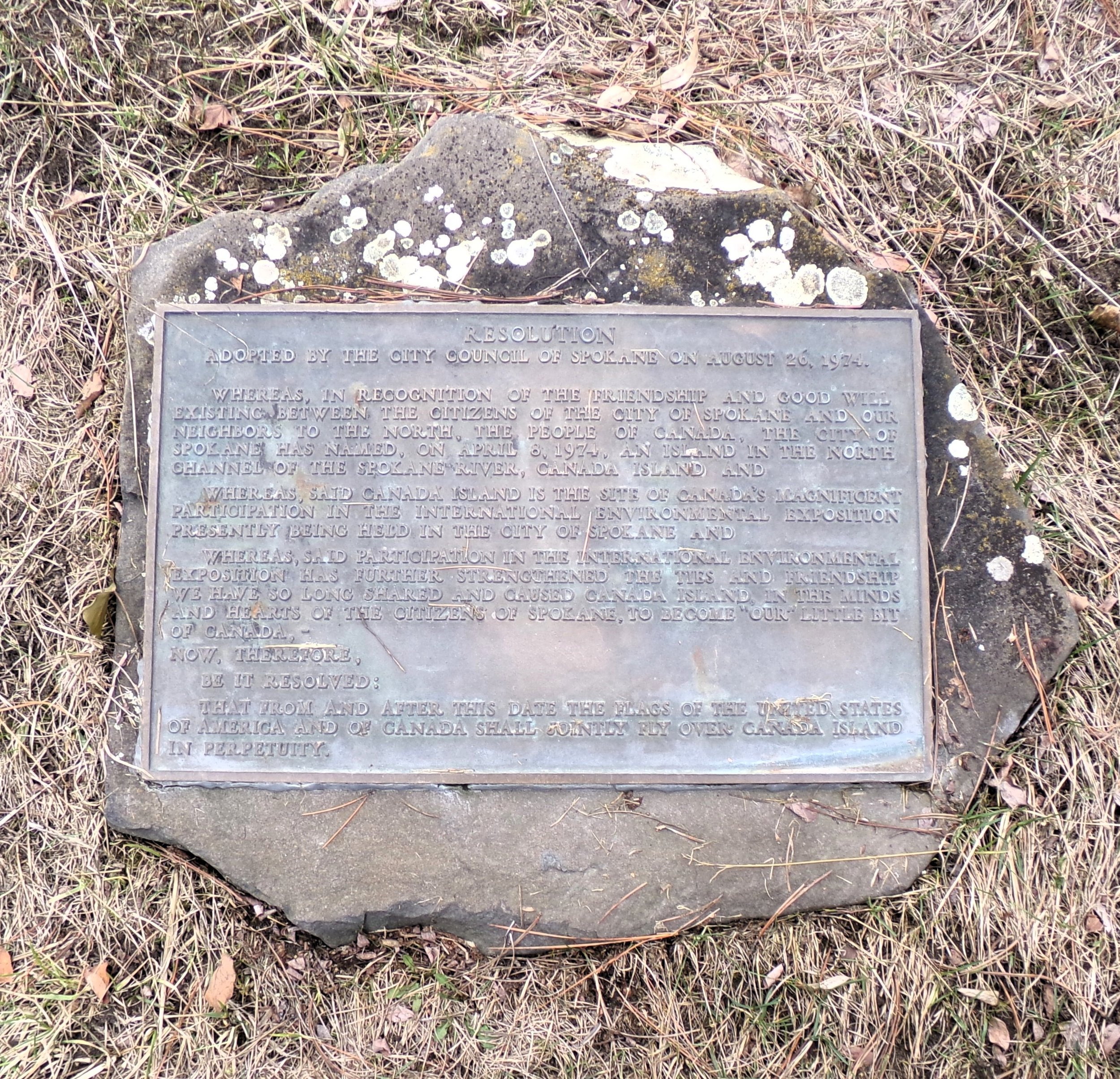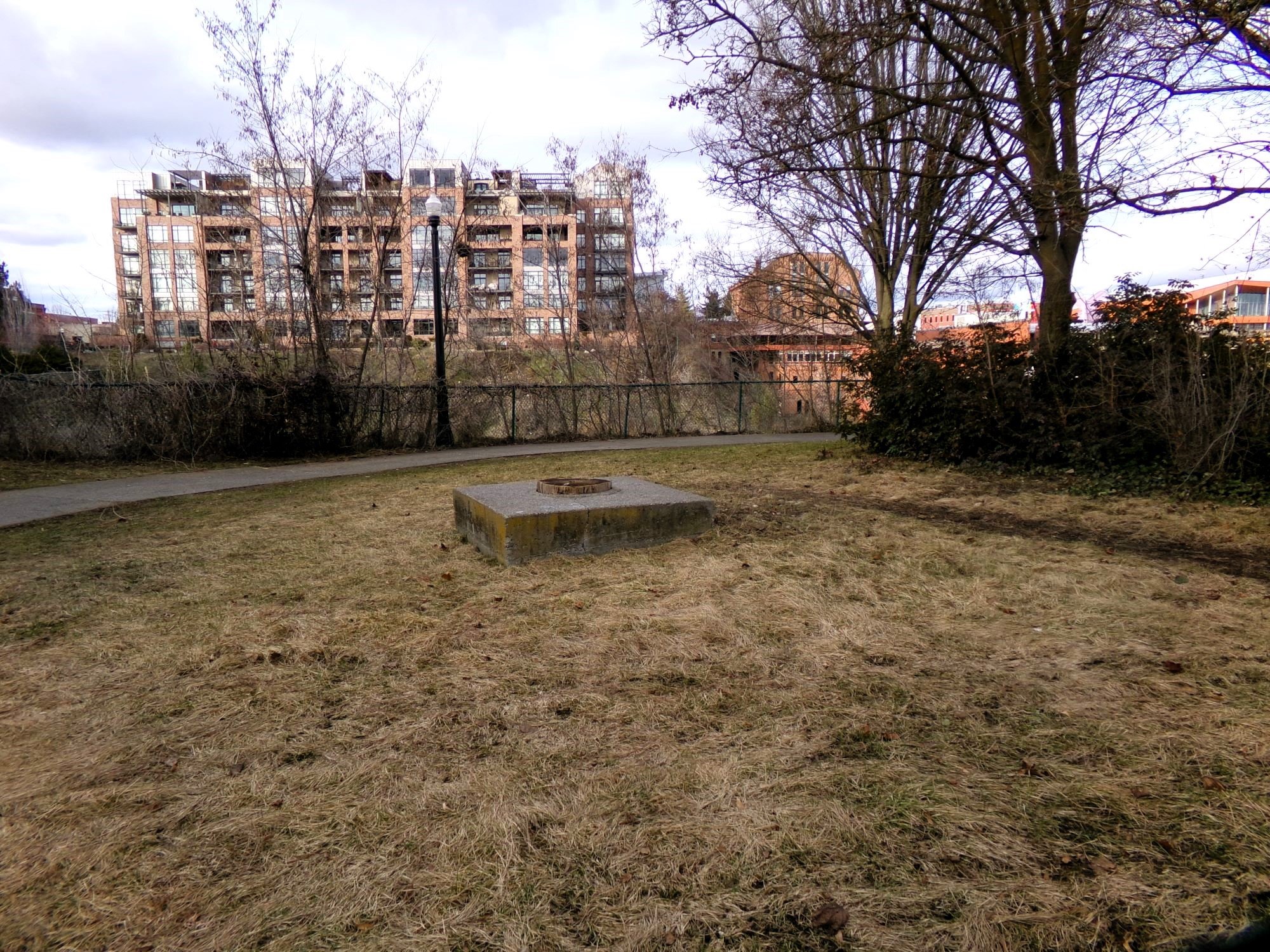Canada Island
“The Canadian exhibit provides a restful haven for the weary. It is of special interest to plant lovers. Approximately 45 different species of evergreen and deciduous trees and perennial plants are flourishing in abundance in the park. The Canadian arboreal exhibition has been built as an expression of Canadian friendship and good will toward the United States, and in particular the citizens of the Pacific Northwest and Spokane. It will remain as a permanent feature of the Spokane Riverside Park after Expo '74 closes.” - Official Expo ‘74 Guidebook.
As planned, Salmon People Island (snxw meneɂ, pronounced “sin-HOO-men-huh”) has remained structurally similar to its configuration as Canada Island for Expo ‘74. Today, some of the plants have been replaced, and those that remain have grown, but several of the Expo structures remain. These include the British Columbia pavilion building, the Alberta Amphitheatre, the flagpoles, and the walkways.
Alberta Amphitheatre
The amphitheatre area is in excellent condition and very recognizable.
A performance at the amphitheatre during Expo ‘74, from ViewMaster slide reel #3. The playground area of Canada Island can be seen in the background at top right.
The amphitheatre area today. Note that the performance stage area no longer has the same floor, but has been filled in with gravel.
British Columbia Pavilion Building
I am not sure whether the park intended to hang onto this building all this time, or whether it has simply survived due to its unobtrusive location and utility for storage. Unlike other Expo ‘74 structures built in this hexagonal design, it was painted a dark brown instead of white, and is much smaller than most of the other pavilion buildings. One of the small pines seen in the image from the Expo postcard has apparently survived and grown much taller than the pavilion that sheltered it.
While the main section of the building has survived, the more open-air section on the west end has not. However, its distinctive hexagonal concrete floor is still present, as are the structural elements that supported the roof.
The years have not been kind to this building, and it has additionally been marred by graffiti and indifferent repairs.
An aside: Pokémon Island
Canada Island saw an unexpected surge of foot traffic in the summer of 2016. The mobile game Pokémon Go designated landmarks as Pokestops, and the high concentration of landmarks on the island made it an optimal location for players to hang out. For a brief time, the island was informally referred to as “Pokémon Island,” and the park accommodated the increase in visitors with additional signage and more trash cans.
U.S. and Canadian Flags
Two flagpoles stand on the island toward its western end. At the base of these flagpoles is a plaque dedicated in 1974, that reads: “Whereas, in recognition of the friendship and good will existing between the citizens of the City of Spokane and our neighbors to the north, the People of Canada, the City of Spokane has named, on April 8, 1974, an island in the north channel of the Spokane River, Canada Island and whereas, said Canada island is the site of Canada’s magnificent participation in the International Environmental Exposition presently being held in the City of Spokane and whereas, said participation in the International Environmental Exposition has further strengthened the ties and friendship we have so long shared and caused Canada Island, in the minds and hearts of the citizens of Spokane, to become “our” little bit of Canada, — now, therefore, be it resolved: that from and after this date the flags of the United States of America and of Canada shall jointly fly over Canada Island in perpetuity.”
As of a visit in February 2024, no flags were on the flagpoles. However, the poles themselves can still be seen.
The former site of Canada Island as seen from across the river, looking north.
Totem Pole
This totem pole was created during Expo ‘74 by Native artists from British Columbia, assisted by visitors to the fair. It was installed on August 29, 1974 in a formal ceremony.
The artist, Hyacinth Joseph “Joe” David, is a legendary master artist of the Northwest. He is from the Tla-o-qui-aht Band of the Nuu-chah-nulth people, and has also been formally adopted by the Haida people. His work is part of the permanent collection of the Metropolitan Museum of Art in New York City and has been featured at the Museum of Art and Design in New York.
Like many of the other artists whose work graced Expo ‘74, David was relatively early in his career when he left his mark on Spokane - he had only just turned 29 when the totem pole was finished. His apprentice, Frank Charlie, was only in his early 20s, and has since gone on to have a stellar career in his own right.
The totem pole soon after being placed in August of 1974.
The totem pole in February of 2024.
While most of the paint has worn away from the upper parts of the totem pole, the colors are more visible on the lower section.
This totem pole stump on the west end of the island is not associated with Expo ‘74. The totem pole in question was erected in 1977 by the Northwest Wildlife Council and was removed in 2019.



















